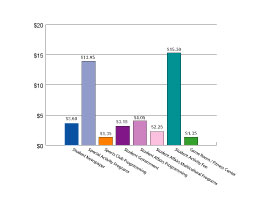Student Fees: Where does the money go?
- October 19, 2004
- |
- Tracy Baker, SGA Corespondent
- Section: Cover
Each semester, students at UTM are charged a Programs and Facilities Fee by the administration. For the fall of 2004, this fee amounted to $236.
The initial amount of $236 is divided into three primary portions: debt services, athletic student activities, and non-athletic student activities.
The debt services fee, which amounts to $87, is used to pay off money owed by the university as a result of the construction of the Elam Center and the Boling University Center. While state funding can be used for the construction and upkeep of academic buildings, these public funds cannot be used to build non-academic buildings on campus, such as the University Center or residential housing, according to university officials. The largest portion of the Programs and Facilities Fee goes to fund athletic student activities. All of the $104 appropriated to this overall athletic budget goes to the UTM athletics program, which encompasses as many as 14 different sports teams. The fee also ensures that sports trainers are maintained on staff at all times during the school year.
As many students may recall, in June 2004, the University Of Tennessee Board Of Trustees approved a $27 increase in the athletic fee. According to Al Hooten, vice chancellor of Finance and Administration, “one element of this increase was to provide additional funding for Title IX issues. This will provide approximately $125,000 which we are reserving only for Title IX expenditures.” In compliance with federal mandates under Title IX, no student at UTM will be discriminated against in an athletic program receiving public funding because of gender.
Finally, $45 of the Programs and Facilities Fee paid this semester by every full-time student goes to fund non-athletic student activities. Among the student programs and facilities that receive a portion of this fund are The Pacer, the Student Government Association, the Student Activities Council, the Fitness Center, and the Game Room.
A large portion of this non-athletic student activity fund is managed by Student Affairs. A part of the student activity fee was used in the renovation of the new Student Life Center; another part of this money goes to Campus Recreation. Other uses of this fund include the purchase of items such as tables and chairs in the University Center and the Student Life Center, as well as the funding of student activities on the Selmer and Jackson extended campuses. Student Affairs Programming provides money for student travel, and covers most costs incurred by student organizations on campus. Multicultural Affairs also receives a part of this non-academic fund. In addition, a sports club reserve fund has recently been created, which Dr. Katie High, vice chancellor for Student Affairs, hopes will be used to create a Ropes course to be used in leadership and management training.
Increases to the Programs and Facilities Fee are proportional to increases in tuition. All full-time students are charged the same amount; the fee for part-time students is based on the number of hours taken.
